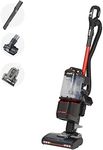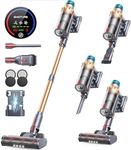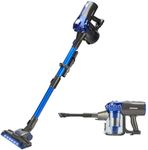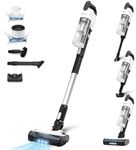Buying Guide for the Best Vacuum Cleaners Pet Hairs
Choosing the right vacuum cleaner for pet hair can make a significant difference in maintaining a clean home. Pet hair can be particularly challenging to remove, so it's important to consider specific features that will help you tackle this task effectively. Here are some key specifications to look for when selecting a vacuum cleaner for pet hair, along with explanations to help you understand their importance and how to choose the best fit for your needs.Suction PowerSuction power refers to the vacuum cleaner's ability to pull in dirt, debris, and pet hair from various surfaces. This is crucial for effectively removing pet hair, which can be deeply embedded in carpets and upholstery. Suction power is often measured in watts or air watts. Higher suction power (above 200 air watts) is generally better for homes with multiple pets or thick carpets, while moderate suction power (100-200 air watts) may suffice for smaller homes or those with hard floors.
Brush RollThe brush roll, or beater bar, is a rotating brush that helps lift pet hair from carpets and upholstery. This feature is essential for loosening and capturing hair that is stuck in fibers. Look for vacuum cleaners with a motorized brush roll, as these are more effective than non-motorized versions. Some models offer tangle-free brush rolls, which are designed to prevent hair from wrapping around the brush, making maintenance easier. If you have a mix of carpet and hard floors, consider a vacuum with an adjustable or switchable brush roll.
Filtration SystemA good filtration system is important for capturing pet dander and allergens, which can improve indoor air quality. High-Efficiency Particulate Air (HEPA) filters are the gold standard, as they can trap 99.97% of particles as small as 0.3 microns. This is particularly beneficial for households with allergy sufferers. Some vacuums also feature washable filters, which can be more cost-effective in the long run. If allergies are a concern, prioritize models with HEPA filtration.
Attachments and AccessoriesAttachments and accessories can enhance the vacuum cleaner's ability to tackle pet hair in various areas of your home. Common useful attachments include pet hair brushes, upholstery tools, and crevice tools. Pet hair brushes are specifically designed to remove hair from furniture and stairs, while upholstery tools can help clean fabric surfaces. Crevice tools are great for reaching tight spaces where pet hair can accumulate. Consider your specific cleaning needs and look for a vacuum that includes the attachments that will be most useful for you.
Bagged vs. BaglessVacuum cleaners come in bagged and bagless models, each with its own advantages. Bagged vacuums tend to be better at containing dust and allergens, as the bags can be sealed and disposed of easily. This can be a good option for allergy sufferers. Bagless vacuums, on the other hand, are more convenient and cost-effective, as you don't need to buy replacement bags. However, emptying the dustbin can release dust and allergens back into the air. Consider your preference for convenience versus allergen containment when choosing between bagged and bagless models.
Weight and ManeuverabilityThe weight and maneuverability of a vacuum cleaner can affect how easy it is to use, especially if you have a large home or multiple levels. Lightweight models (under 15 pounds) are easier to carry and maneuver, making them a good choice for homes with stairs. Some vacuums also feature swivel steering, which allows for better control and easier navigation around furniture. If you have mobility issues or a large home, prioritize a vacuum that is easy to handle and move around.
Noise LevelVacuum cleaners can be noisy, which can be stressful for pets and disruptive to your household. Noise level is measured in decibels (dB), and quieter models typically operate at around 60-70 dB. If you have noise-sensitive pets or prefer a quieter cleaning experience, look for vacuums that are specifically designed to operate quietly. Keep in mind that higher suction power can sometimes mean more noise, so you may need to balance these factors based on your priorities.












![Hoover HF1 Plus Pet Flexi Cordless Stick Vacuum Cleaner with Flexi Tube, Pet Hair Tool, Turbo Suction Mode, Up to 45min Runtime, LED Lights, Multi-Floor Nozzle, Handheld Capability, 165w [HF1PZ10PX]](https://images-proxy.bestreviews.guide/iONRYWNxHq3VqJK3E8zknlBWfOM=/0x150/https://m.media-amazon.com/images/I/412krr3XRDL._AC_CX679_.jpg)
![Hoover HF6 Pet Cordless Stick Vacuum Cleaner with Pet Hair Tool, Floor Sensor, Dual Way Clean, Up to 100 Min Runtime,Anti Hair Wrap,Double Edge Cleaning, Versatile,QuickPark,Portable, 660w [HF610P]](https://images-proxy.bestreviews.guide/J6oqPn2yypa4ig3TqZDBm_MmJ-M=/0x150/https://m.media-amazon.com/images/I/41CAd8CA1CL._AC_CX679_.jpg)


